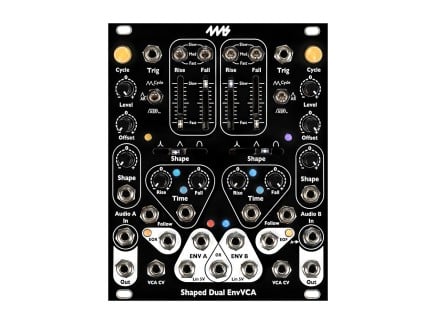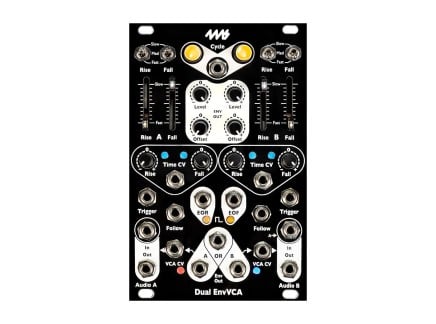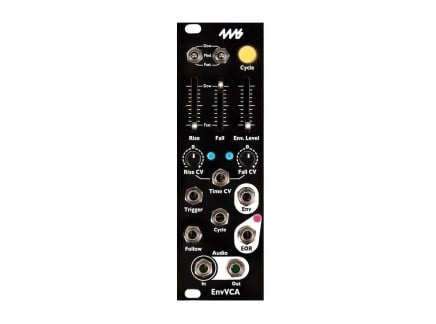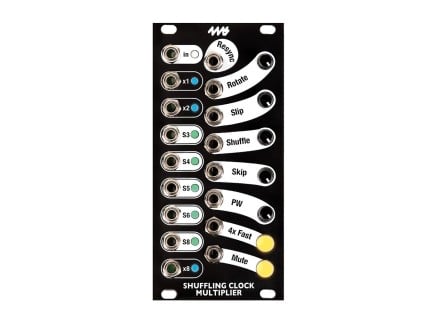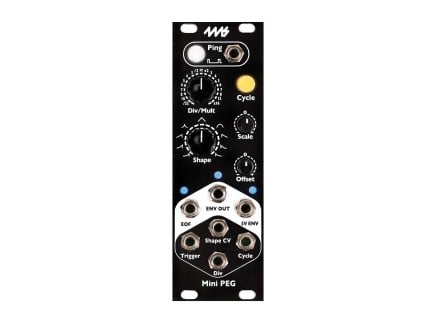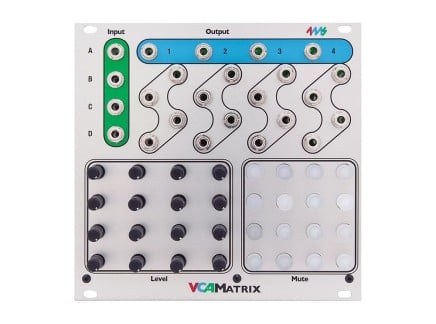In recent years, Eurorack synthesizer manufacturer 4MS have made a splash with a number of quite sophisticated digital modules for sound creation and manipulation: the complex Ensemble Oscillator, Spherical Wavetable Navigator, Spectral Multiband Resonator, and so on. In some ways, modules like these have taken center stage among their offerings. However, once upon a time, 4MS was primarily known for simpler, bread-and-butter utilities—the types of modules that truly acted as a structural backbone of tons of systems—the utilitarian glue that turned many a modular synthesizer into a well-rounded, highly-organized instrument. In fact, in the first half of the 2010s, it was rare to see a forward-thinking system that didn't have a Pingable Envelope Generator, a Rotating Clock Divider, a Shuffling Clock Multiplier, VCA Matrix, etc.
In the ensuing years, as more manufacturers entered the Eurorack fold and offered their own alternatives on classic synthesis and control concepts, 4MS moved on to the advanced digital designs mentioned above. But now, in 2022, we've seen a return to concepts from some of their earliest Eurorack designs: most directly, this year saw the release of the Mini PEG, a single-channel version of the Pingable Envelope Generator, and the SCM+, an all-in-one repackaging of the Shuffling Clock Multiplier and its dedicated Expander. These designs are breath of fresh air, and an excellent reminder that the tools 4MS developed nearly a decade ago are still quite clever and effective solutions to common musical problems.
In the spirit of these earlier designs, 4MS also introduced some new modules this year, each of which present a slightly different take on yet another set of common musical tasks. I'm talking about the EnvVCA series: three modules that each combine envelope and VCA circuits in order to cover a broad range of control voltage generation, sound manipulation, and CV processing duties. These might seem simple at first, but each offers a host of advanced controls that remind us: sometimes, the most fundamental concepts in synthesis still offer plenty of new, unexplored territory.
As of the time of publishing this article, the EnvVCA series is finally shipping—so check out the video above for some of our Patch Pal Jacob's thoughts on the new EnvVCA series...and read on for an overview of each of the modules in the trio.
4MS EnvVCA Series Overview + Comparison
Three distinct modules comprise the EnvVCA series: the single-channel EnvVCA, the Dual EnvVCA, and the Shaped Dual EnvVCA. As you might expect, there's a fair amount of overlap between these, so let's take a look at all three to understand the differences. We'll start with the simplest, the EnvVCA, and then work our way up through the series, identifying the additions/differences on each model as we go.
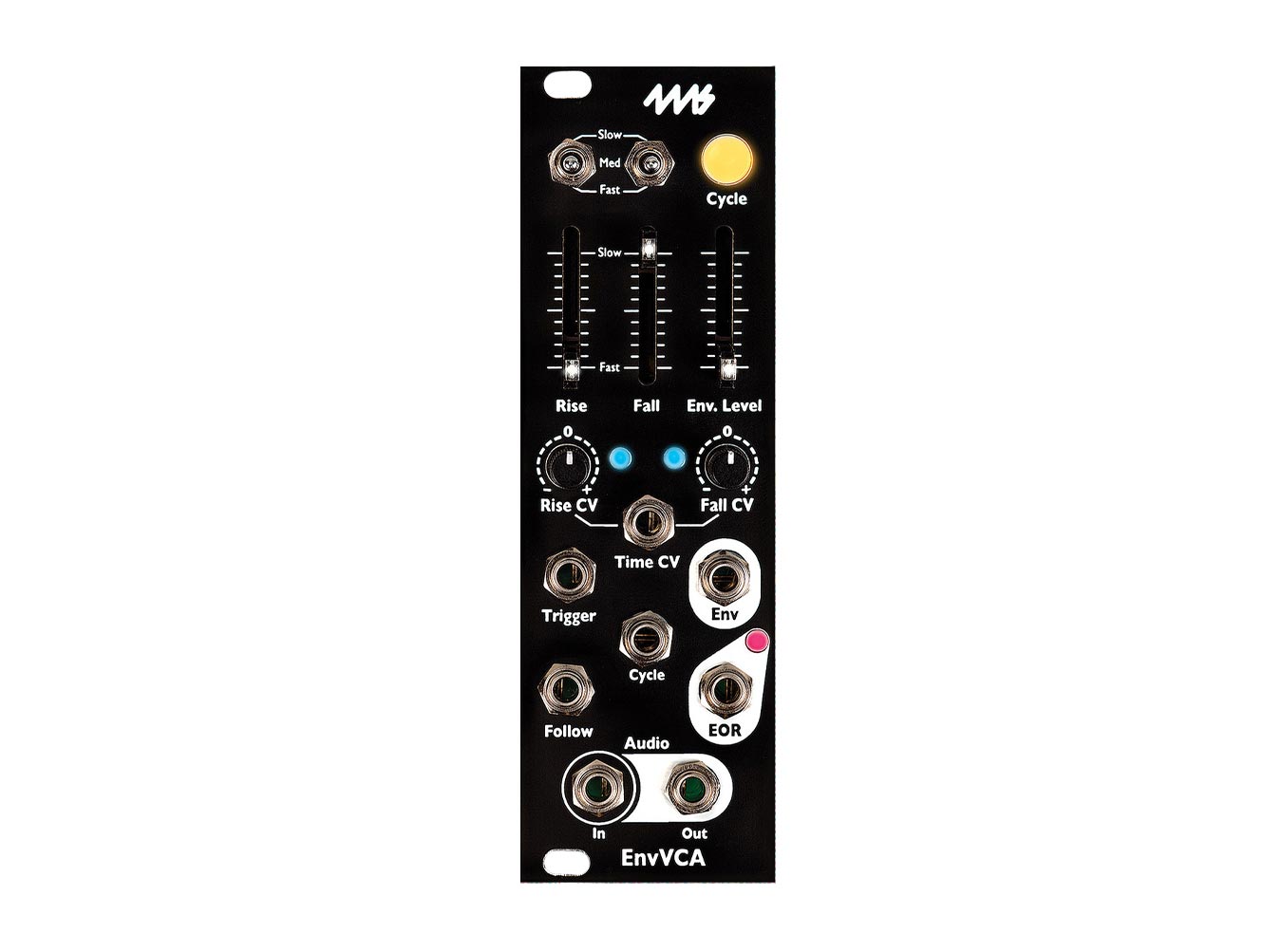
The EnvVCA is an 8hp-wide module that combines a fully-featured envelope with a low-noise, exponential, DC-coupled VCA—ultimately, great for end-of-voice audio articulation or processing of external control voltages. The envelope section is an AD/ASR envelope with a variety of controls. The envelope's stage durations are controlled through a number of means: independent rise and fall range switches (with slow, medium, and fast ranges), independent sliders for rise and fall time, and a shared CV input with independent attenuverters for rise and fall time. It's important to note that, with the panel controls alone, the envelope rise and fall times range from barely over one millisecond all the way to two minutes—and with external CV, you can get frequencies as high as 10kHz all the way to 30 minutes. This is an insanely wide frequency range, and it's one of these modules' overall most important/outstanding features.
The EnvVCA's envelope may be triggered via external gates/pulses, in which case it acts as a simple, triggered AD envelope. Alternatively, gates (or other signals!) may be connected to the Follow input. When a gate is applied to the follow input, you can create ASR envelope shapes—and when applying other shapes, you can use the rise and fall controls to dial in slew limiting with independent rise and fall times. This makes the module's relationship to classic slew limiters (like the Serge DUSG and the more modern Make Noise Maths) quite apparent.
The envelope features a dedicated output with a continuously variable level control. The envelope also offers an End of Rise gate output, and can be made to self-cycle by either pushing the Cycle toggle button, or by sending an external gate into the Cycle input. The envelope has a dedicated output for use as modulator for external signals. Additionally, the module's VCA is internally connected to the envelope's output—so, on the standard EnvVCA, the VCA amplitude is always tied to the internal envelope generator.
Understanding all of these aspects of the standard EnvVCA is important in describing the differences in the other models. So now, let's proceed by taking a closer look at the next step up in this lineup: the Dual EnvVCA.
The Dual EnvVCA might at first seem like it's simple a two-channel version of the standard model...but it has a number of extra features packed in as well.
Items of note: the Dual EnvVCA doesn't necessarily require the use of the internal envelopes for each of its two VCAs. Instead, you also have the option of using external CV to control the VCAs. Unlike the standard model, the envelopes on Dual EnvVCA offer both bipolar level controls and voltage offsets, for finer tuning of the output voltage range. Cycling behavior can be toggled independently for each channel via the dedicated buttons, but the Cycle gate input is shared between channels. The left envelope offers an End of Rise gate output, while the right offers an End of Fall gate; and finally, the module offers and "analog OR" output, which compares both envelopes and produces the voltage from whichever of the pair is higher at any given time.
It's worth noting that Dual EnvVCA's time ranges are a bit different from the single module: 4MS states the panel controls will get you rise and fall times from ~1.25milliseconds to 5 minutes, while external CV can extend this range to go from ~125 microseconds (8kHz) to around 30 minutes.
These technical distinctions aside, the creative uses for two envelopes and two VCAs extend well beyond what a spec sheet will explain. These could be used as end-of-voice articulation generators, as independent slew limiters, as the basis of a dual-voice sidechain compression-like setup, or as a knotted web of interweaving, cross-modulated voltages. When you have the ability to generate such a wide range of signals, the ability to slew signals, and the ability to scale the amplitude of signals all in a single module, you may quickly realize that all the standard tasks of a synthesizer—sound generation, waveshaping, filtering, modulation, generating articulation, etc.—are all covered by this simple toolkit.
The final module in the series, the Shaped Dual EnvVCA, tacks on even more bells and whistles. This is the only module of the series to feature a dedicated mode switch, offering AD, ASR, and cycling behavior all under control of a single switch and trigger input per channel (and, of course, the Cycle toggle switches on each channel are still intact). The envelopes retain the Follow input for use as a slew limiter, but for simple envelope behaviors, you need not use the follow input on this module: the trigger inputs and mode select switches alone will cover that functionality.
Most other features are the same: you still get envelope outputs with variable level control and offset, VCAs with internal (defeatable) normalled connections to the envelopes, an analog OR comparison of both envelopes, time CV input per envelope with independent Rise and Fall attenuverters, etc. In addition to the scaled envelope outputs, you gain dedicated 0–5V envelope outputs for each envelope, which retain their range regardless the per-channel level/offset controls. Again, the Shaped Dual Env VCA has slightly different time ranges available as well: the 4MS site states a panel control range of ~2 millisecond–2 minute rise and fall times, with external CV expanding the range to ~400 microsecond (2.5kHz) to 1 hour durations.
The true strong suit of the Shaped Dual EnvVCA, though, is in its name: it adds envelope shape controls. Each envelope offers a continuously variable shape control, ranging from snappy exponential responses through straight linear response and all the way to steep logarithmic response—all without altering the envelope's total duration/frequency. Additionally, each channel offers a shape CV input, allowing you to continuously vary the response shape over time for complex, ever-changing modulation curves.
The Newest Swiss Army Knife for Your Eurorack System
The EnvVCA series represents a power exploration of classic synthesis techniques—pushing familiar techniques and control structures into extreme territory, and combining them in a way that makes an astonishing number of sound design tasks dead simple. It's hard to imagine a system that couldn't make use of one (or more!) of these modules.
All in all? They're a great value. Every system needs envelopes, LFOs, and VCAs, and these modules offer that functionality in droves...but once you start exploring some of their extended functionality, you'll be able to find more. You can use the envelopes as wide-range audio oscillators. You can use the envelopes as clock dividers. You can use them as slew limiters—you could even use portions of the Dual EnvVCA modules as rectifiers, envelope followers, and much more. The way that the ubiquitous Make Noise Maths provides tons of tricks based on slew limiting, mixing, and simple analog logic, the EnvVCA modules delve into the utility offered by combining extremely wide range slew limiters with dynamic signal scaling (in the form of VCAs).
You could think of them as just being envelopes and VCAs if you like...but you'll quickly find that they cover an astonishing range of functions when thoughtfully patched. Could these be the Maths of 2022? Very possibly—and of course, they'd all make great patch companions. I'd be surprised if we don't start seeing quite a few EnvVCAs out in the wild. These might just be the new go-to Swiss-army knife of raw synthesis functionality.

